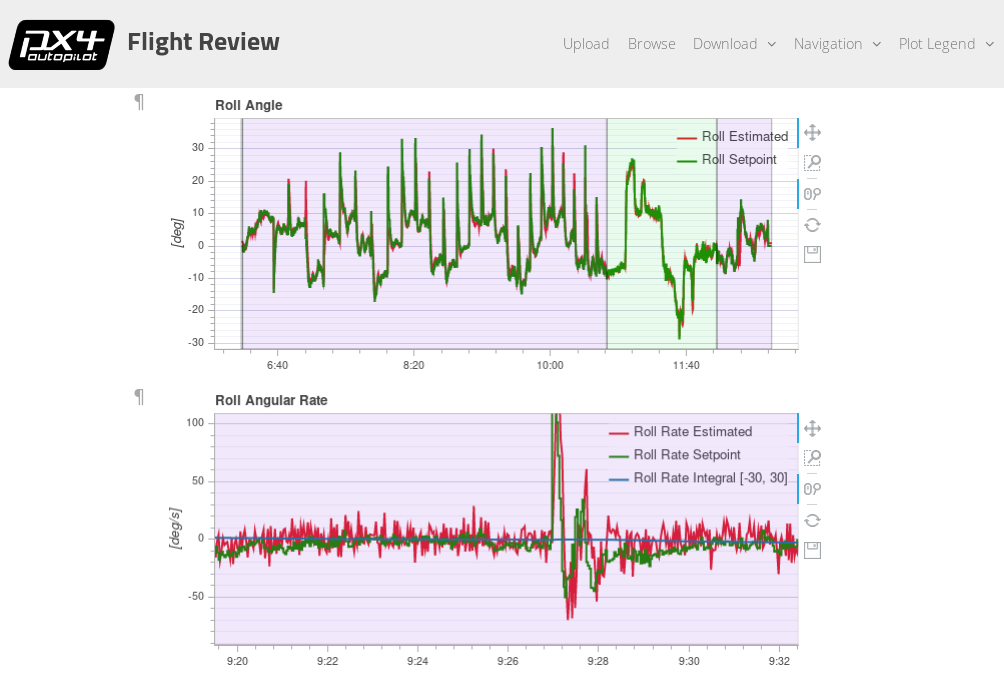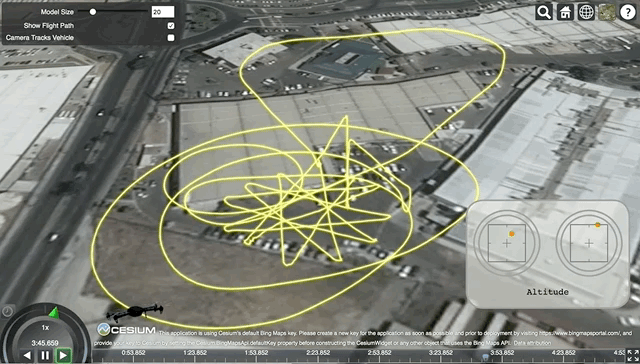This is a web application for flight log analysis. It allows users to upload ULog flight logs, and analyze them through the browser.
It uses the bokeh library for plotting and the Tornado Web Server.
Flight Review is deployed at https://review.px4.io.
- Python3 (3.6+ recommended)
- SQLite3
- http://fftw.org/
sudo apt-get install sqlite3 fftw3 libfftw3-devNote: Under some Ubuntu and Debian environments you might have to install ATLAS
sudo apt-get install libatlas3-basemacOS already provides SQLite3. Use Homebrew to install fftw:
brew install fftw# After git clone, enter the directory
git clone https://github.com/PX4/flight_review.git
cd flight_review/app
pip install -r requirements.txt
# Note: preferably use a virtualenv- By default the app will load
config_default.iniconfiguration file - You can override any setting from
config_default.iniwith a user config fileconfig_user.ini(untracked) - Any setting on
config_user.inihas priority overconfig_default.ini - Run
setup_db.pyto initialize the database.
Note: setup_db.py can also be used to upgrade the database tables, for
instance when new entries are added (it automatically detects that).
For local usage, the server can be started directly with a log file name, without having to upload it first:
cd app
./serve.py -f <file.ulg>To start the whole web application:
cd app
./serve.py --showThe plot_app directory contains a bokeh server application for plotting. It
can be run stand-alone with bokeh serve --show plot_app (or with cd plot_app; bokeh serve --show main.py, to start without the html template).
The whole web application is run with the serve.py script. Run ./serve.py -h
for further details.
The plotting can also be used interative using a Jupyter Notebook. It requires python knowledge, but provides full control over what and how to plot with immediate feedback.
- Start the notebook
- Locate and open the test notebook file
testing_notebook.ipynb.
# Launch jupyter notebook
jupyter notebook testing_notebook.ipynbThe web site is structured around a bokeh application in app/plot_app
(app/plot_app/configured_plots.py contains all the configured plots). This
application also handles the statistics page, as it contains bokeh plots as
well. The other pages (upload, browse, ...) are implemented as tornado handlers
in app/tornado_handlers/.
plot_app/helper.py additionally contains a list of log topics that the plot
application can subscribe to. A topic must live in this list in order to be
plotted.
Tornado uses a single-threaded event loop. This means all operations should be non-blocking (see also http://www.tornadoweb.org/en/stable/guide/async.html). (This is currently not the case for sending emails).
Reading ULog files is expensive and thus should be avoided if not really necessary. There are two mechanisms helping with that:
- Loaded ULog files are kept in RAM using an LRU cache with configurable size (when using the helper method). This works from different requests and sessions and from all source contexts.
- There's a LogsGenerated DB table, which contains extracted data from ULog for faster access.
In addition to in-memory caching there is also some on-disk caching: KML files are stored on disk. Also the parameters and airframes are cached and downloaded every 24 hours. It is safe to delete these files (but not the cache directory).
Bokeh uses dynamic code loading and the plot_app/main.py gets loaded on each
session (page load) to isolate requests. This also means we cannot use relative
imports. We have to use sys.path.append to include modules in plot_app from
the root directory (Eg tornado_handlers.py). Then to make sure the same module
is only loaded once, we use import xy instead of import plot_app.xy.
It's useful to look at print('\n'.join(sys.modules.keys())) to check this.
This section explains how to work with docker.
Edit the .env file according to your setup:
- PORT - The number of port, what listen service in docker, default 5006
- USE_PROXY - The set his, if you use reverse proxy (Nginx, ...)
- DOMAIN - The address domain name for origin, default = *
- CERT_PATH - The SSL certificate volume path
- EMAIL - Email for challenging Let's Encrypt DNS
- /opt/service/config_user.ini - Path for config
- /opt/service/data - Folder where stored database
- .env - Environment variables for nginx and app docker container
cd app
docker build -t px4flightreview -f Dockerfile .Run the following command to start docker container.
Please modify the .env and add app/config_user.ini with respective stages.
Uncomment the BOKEH_ALLOW_WS_ORIGIN with your local IP Address when
developing, this is for the bokeh application's websocket to work.
docker-compose -f docker-compose.dev.yml upTest locally with nginx:
docker-compose upRemember to Change NGINX_CONF to use default_ssl.conf and add the EMAIL
for production.
htpasswd -c ./nginx/.htpasswd username
# here to create a .htpasswd for nginx basic authentication
chmod u+x init-letsencrypt.sh
./init-letsencrypt.shContributions are welcome! Just open a pull request with detailed description why the changes are needed, or open an issue for bugs, feature requests, etc...

